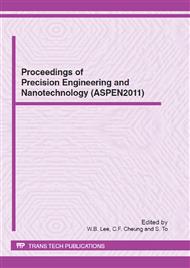p.54
p.60
p.66
p.73
p.79
p.84
p.90
p.96
p.102
Experimental Research on Smooth Surface Polishing Based on the Cluster Magnetorheological Effect
Abstract:
A new planarization polishing method, based on the cluster magnetorheological (MR) effect and using MR fluid to form the flexible polishing pad, is presented in this paper to polish optical glass. To explore the machining characteristic of the viscid and flexible polishing pad based on the cluster MR-effect, some process experiments were conducted to reveal the influence of the machining gap, the speed of the polishing disc and the polishing time on the machining effect. The results indicate that the viscid and flexible polishing pad based on the cluster MR-effect under a strong magnetic field can reduce surface roughness effectively. When the strength of the magnetic field is 2000Gs, and the content of the carbonyl iron is 12%, the surface roughness can be reduced rapidly from the original Ra0.27μm to Ra1.4nm based on the cluster MR-effect.
Info:
Periodical:
Pages:
79-83
Citation:
Online since:
June 2012
Authors:
Keywords:
Price:
Сopyright:
© 2012 Trans Tech Publications Ltd. All Rights Reserved
Share:
Citation:


